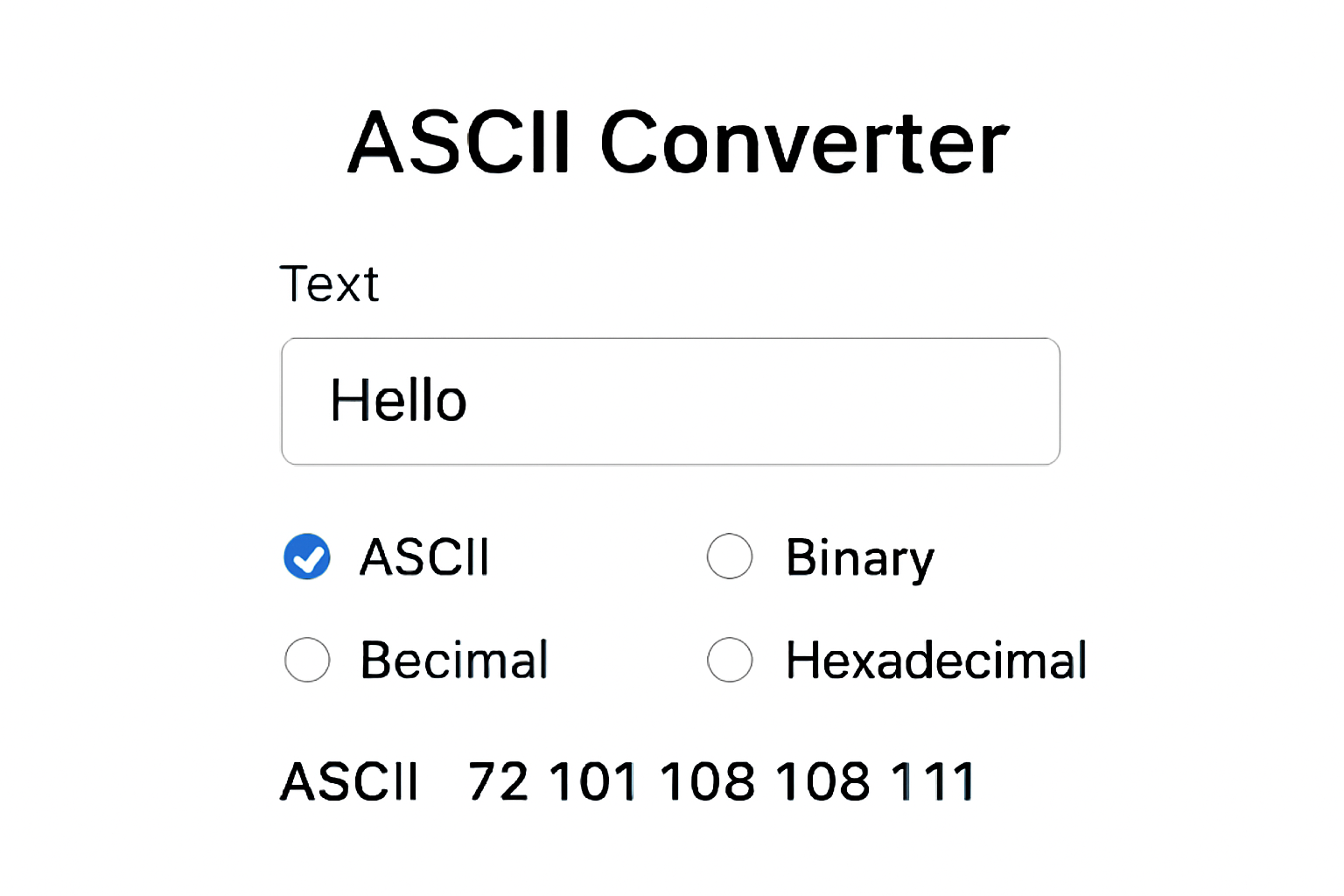
Ascii converter
Created on 2 October, 2025 • Converter Tools • 12 views • 3 minutes read
An ASCII Converter is a tool used to convert text or characters between the ASCII (American Standard Code for Information Interchange) format and other formats like binary, decimal, and hexadecimal. ASCII is a character encoding standard that represents te
ASCII Converter: A Comprehensive Guide to Converting Text and DataWhat is an ASCII Converter?
An ASCII Converter is a tool used to convert text or characters between ASCII (American Standard Code for Information Interchange) format and other types of data formats, such as binary, decimal, and hexadecimal. ASCII is a character encoding standard that represents text in computers and electronic devices by using numeric codes. It is one of the oldest encoding schemes, with each character represented by a 7-bit number, enabling computers to handle text-based data efficiently.
This converter is especially useful for developers, programmers, and IT professionals who need to work with raw data or transfer information between different systems. By converting data into ASCII format or vice versa, users can understand how text is represented at the machine level and perform necessary transformations or debugging.
Why is ASCII Important?
ASCII serves as the foundation for encoding characters in computing systems. Initially developed in the early 1960s, it became widely adopted in computing and communication devices. It supports 128 unique characters, including:
Control characters (e.g., newline, carriage return, tab),
Printable characters (letters, digits, punctuation marks, and symbols).
As newer and more complex encoding schemes, such as Unicode, emerged, ASCII remained relevant because of its simplicity and compatibility with other formats.
How Does an ASCII Converter Work?
An ASCII converter takes a string of characters or numerical data and converts them between human-readable formats and their corresponding ASCII representations. For instance:
Text to ASCII: Converts letters, digits, and symbols into their numeric ASCII code equivalents.
ASCII to Text: Converts ASCII codes back into the readable characters that they represent.
These conversions are essential for tasks like encoding or decoding messages, verifying data integrity, or transferring files between different platforms where ASCII representation is required.
Converting Between ASCII Formats
Text to Binary: An ASCII converter can represent characters as binary code. Each ASCII character is represented by a 7-bit binary number, which can be expanded to an 8-bit number in certain systems.
Text to Decimal: Each ASCII character is converted to a decimal value that corresponds to its character code.
Text to Hexadecimal: Similar to binary and decimal conversions, ASCII can also be represented in hexadecimal, a more compact form of binary.
For example, the letter A in ASCII corresponds to the decimal value 65, binary 01000001, and hexadecimal 41.
Key Features of an ASCII Converter
Multi-format Conversion: An ASCII converter supports converting data from text to ASCII, binary, decimal, and hexadecimal and vice versa, allowing for versatile use in various programming and networking tasks.
Real-Time Results: Some converters offer real-time conversions, providing immediate results as the user types or inputs data.
Easy to Use: Most ASCII converters are designed with a user-friendly interface, requiring no programming skills. Simply input the text or ASCII code, and the tool displays the converted result.
Error Checking: Some converters come with built-in validation, ensuring that only valid ASCII codes or text characters are entered, avoiding data corruption during conversion.
Applications of an ASCII Converter
1. Programming and Software Development
In software development, especially when working with low-level operations or debugging, ASCII codes are used to represent characters and symbols. Developers use ASCII converters to test or visualize how data is stored and manipulated at the binary or hexadecimal level.
2. Networking and Data Transfer
ASCII plays a key role in protocols such as FTP, HTTP, and SMTP, where data is transmitted as ASCII text. An ASCII converter can be used to ensure proper encoding/decoding during data transfer, especially when transferring text-based data over the internet.
3. Debugging and Data Integrity Checks
During debugging, developers often need to inspect the raw ASCII representation of data to ensure that information is correctly encoded and decoded. An ASCII converter can help identify problems in the data conversion process, especially in text-processing systems.
4. Cryptography and Security
In cryptography, encoding data in ASCII format is often used in processes like hashing or encryption. ASCII converters are used to visualize the encoded text or decode encrypted messages.
Conclusion
An ASCII Converter is a vital tool for anyone involved in programming, data transfer, or debugging. By allowing easy conversions between text and ASCII, it helps individuals understand how data is encoded, decoded, and transmitted across systems. Whether you're a software developer, network engineer, or security professional, an ASCII converter simplifies working with raw text data, ensuring better data manipulation and smooth operation of your programs. By incorporating an ASCII converter into your toolkit, you can improve efficiency and gain a deeper understanding of how information is handled in the world of computing.
Popular posts
-
Barcode readerMisc Tools • 23 views
-
Color pickerMisc Tools • 21 views
-
SHA-256 generatorGenerator tools • 17 views
-
Exif readerMisc Tools • 17 views
-
Ip LookupChecker Tools • 16 views